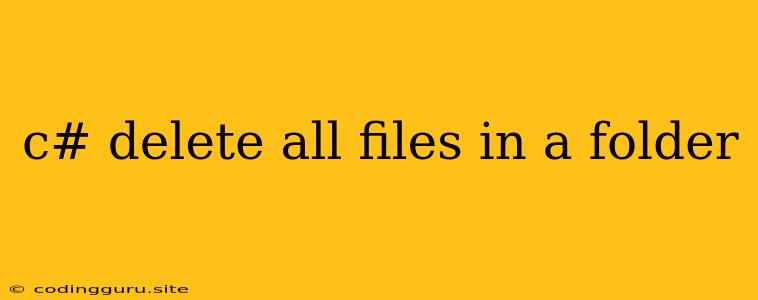How to Delete All Files in a Folder using C#
Deleting all files within a specific folder in C# can be a common task when you need to clean up temporary files, prepare a directory for new data, or manage your application's resources. This guide will walk you through the process, covering essential steps and providing code examples to help you achieve this efficiently.
Understanding the Requirements
Before diving into code, it's crucial to understand the specific requirements for your task:
- Folder Path: You need to specify the exact path of the folder containing the files you want to delete. This path can be absolute (e.g., "C:\Users\Public\Documents") or relative (e.g., ".\Temp").
- File Selection: Do you want to delete all files within the folder, or are you targeting specific files based on their names, extensions, or other criteria?
Basic Deletion Using Directory.Delete
The simplest approach involves using the Directory.Delete method. However, this method will delete the entire folder and its contents irrevocably. If you only want to delete files, this isn't the right solution.
string folderPath = @"C:\Users\Public\Documents\Temp"; // Specify your folder path
// This will delete the entire folder and its contents
try
{
Directory.Delete(folderPath, true); // true: delete all subdirectories
Console.WriteLine("Folder deleted successfully.");
}
catch (Exception ex)
{
Console.WriteLine("Error deleting folder: " + ex.Message);
}
Deleting Files with Directory.EnumerateFiles and File.Delete
This method provides more granular control, allowing you to delete only files while leaving the folder itself intact.
string folderPath = @"C:\Users\Public\Documents\Temp"; // Specify your folder path
try
{
// Get all files in the folder
foreach (string file in Directory.EnumerateFiles(folderPath))
{
// Delete each file
File.Delete(file);
Console.WriteLine($"File '{file}' deleted.");
}
Console.WriteLine("All files deleted successfully.");
}
catch (Exception ex)
{
Console.WriteLine("Error deleting files: " + ex.Message);
}
This code iterates through all files in the specified folder and deletes each one using the File.Delete method.
Handling Errors and Exceptions
The try...catch blocks in the code snippets above are crucial for handling potential errors. Errors might occur if the folder path is invalid, if the files are inaccessible, or if permissions prevent deletion.
Important Considerations:
- File Permissions: Ensure your application has the necessary permissions to access and delete files in the specified folder.
- File Locking: If a file is currently being used by another process, you'll need to handle this situation. You might need to find a way to temporarily release the lock or implement a mechanism to retry the deletion later.
- Subfolders: If you need to delete files within subfolders, you'll need to modify the code to recursively traverse the directory structure.
Filtering Files for Deletion
You can use Directory.EnumerateFiles with a wildcard pattern to select specific files for deletion. For example:
// Delete only files with the .txt extension
foreach (string file in Directory.EnumerateFiles(folderPath, "*.txt"))
{
File.Delete(file);
}
Conclusion
Deleting all files in a folder using C# is a straightforward process once you understand the fundamentals. The Directory.EnumerateFiles and File.Delete methods provide the most control over file deletion, while the try...catch blocks are essential for robust error handling. Remember to consider file permissions, locking issues, and subfolders when implementing this task in your applications.
